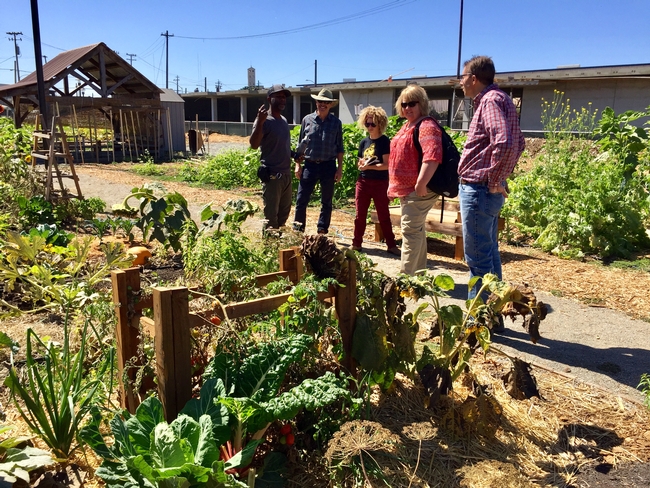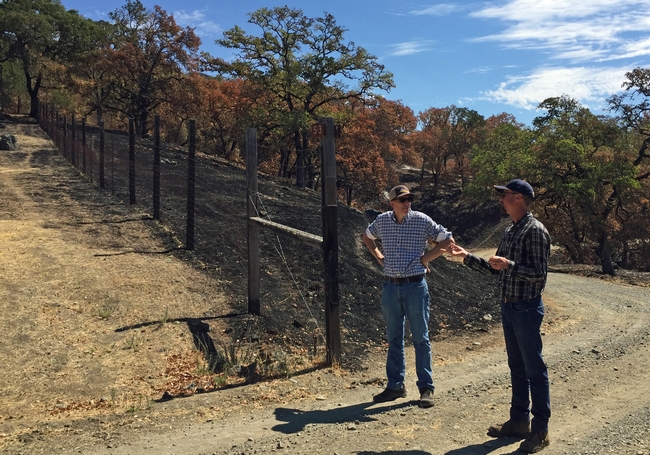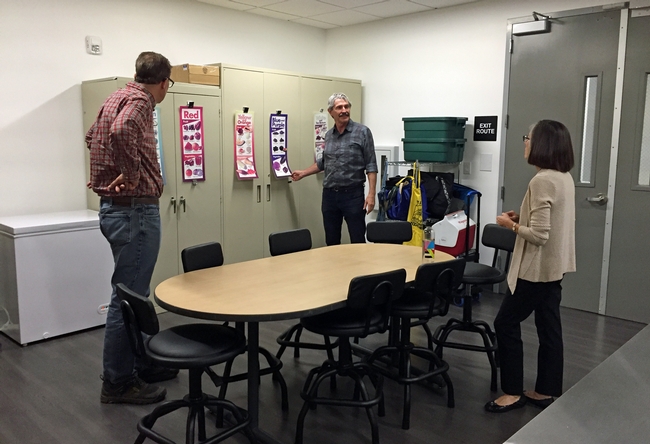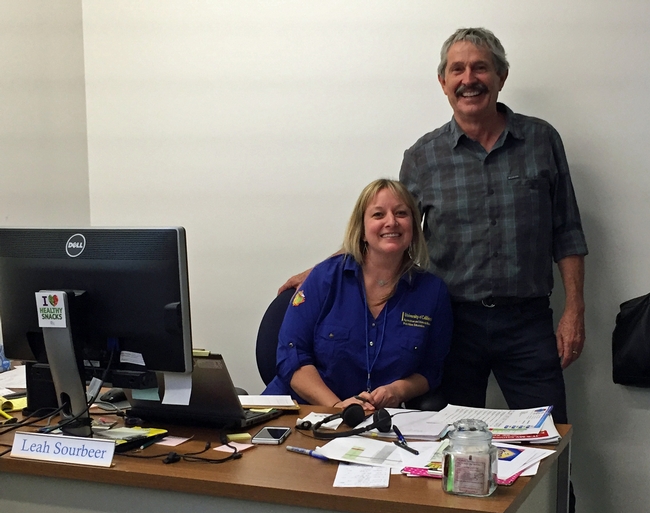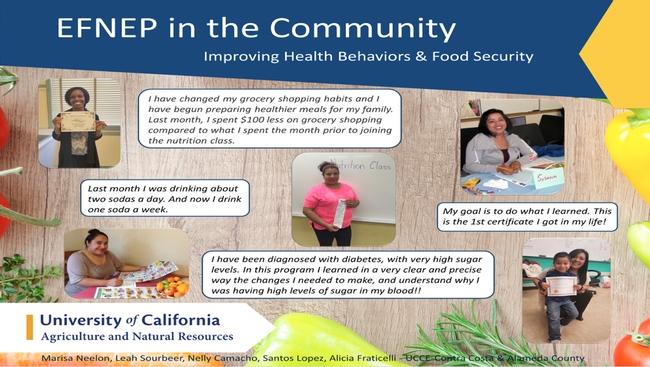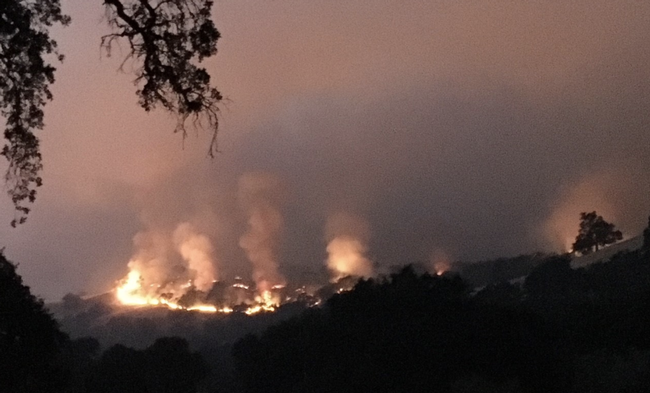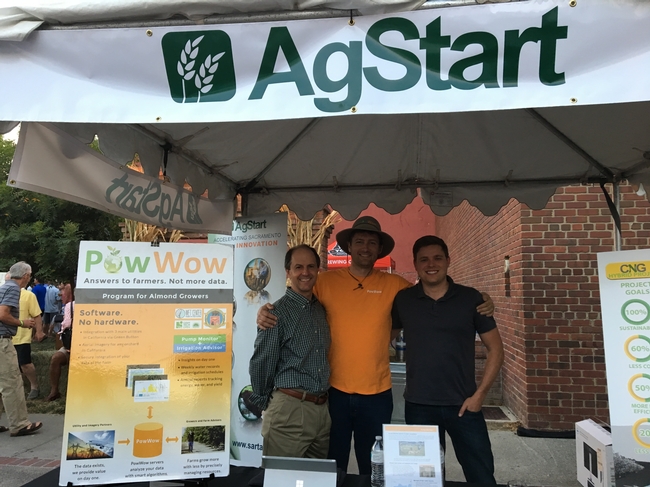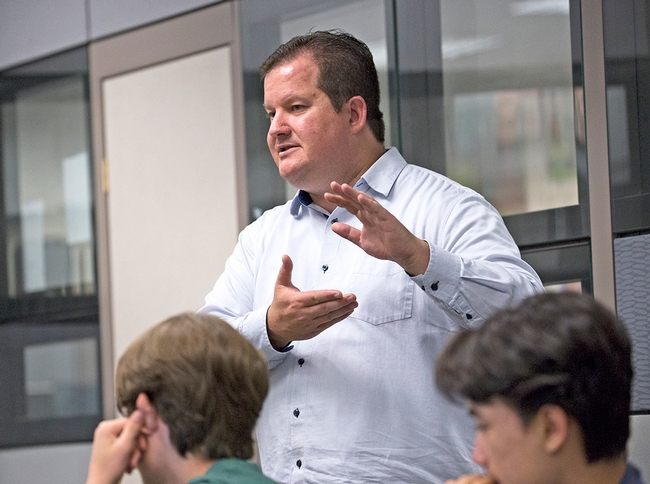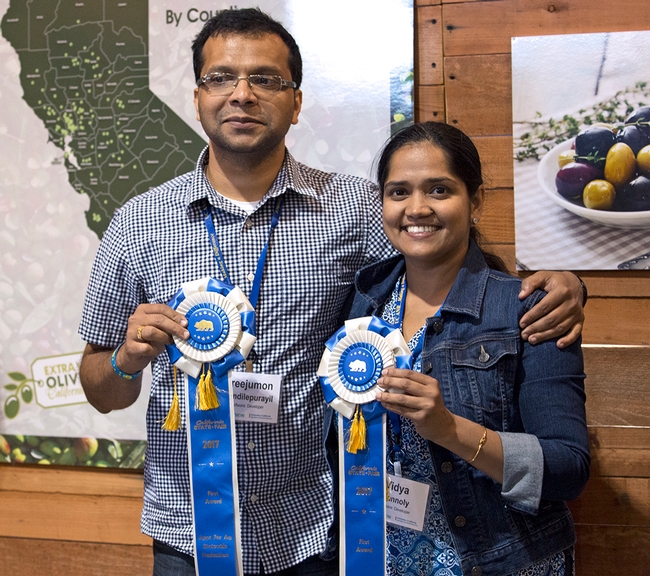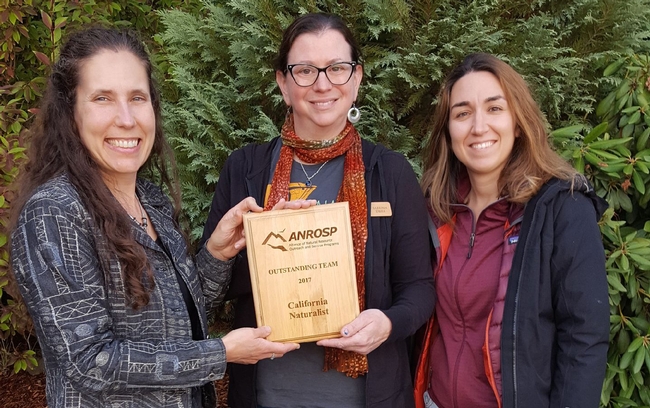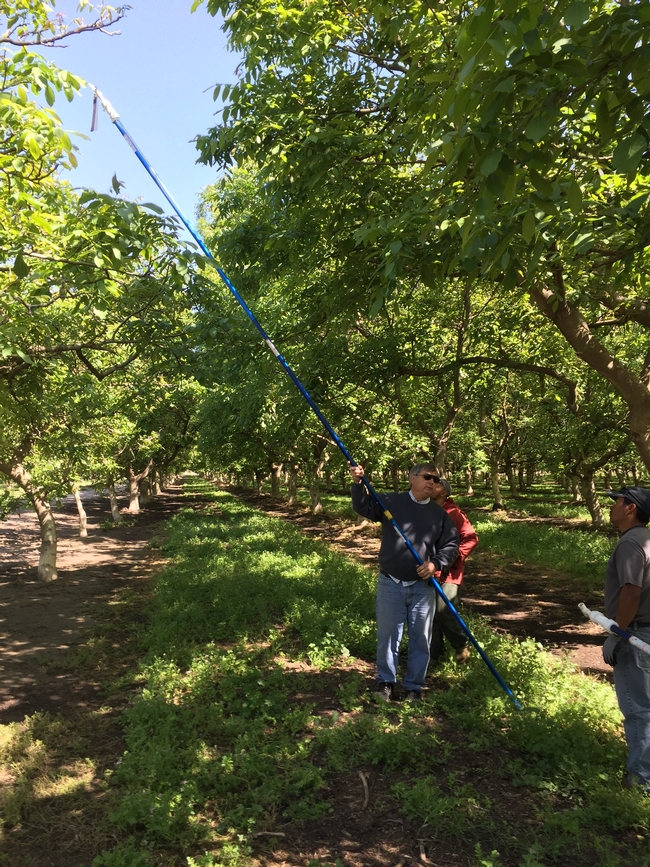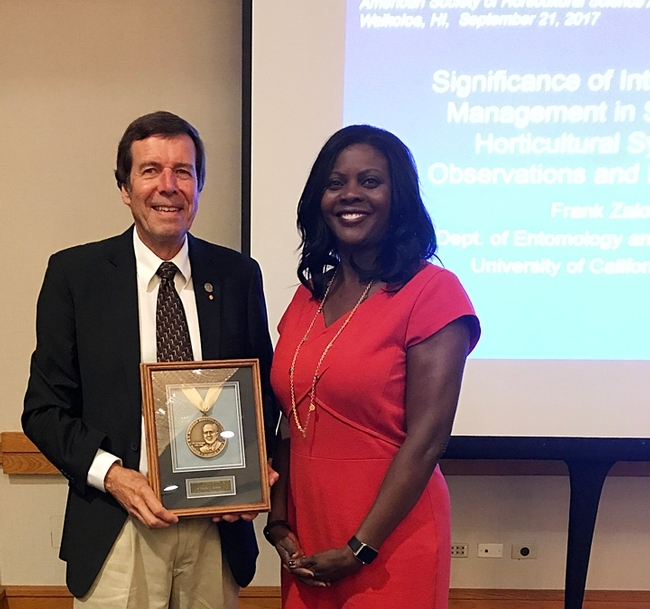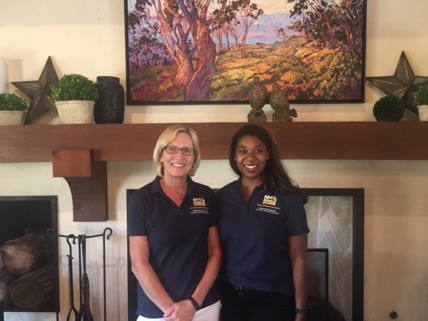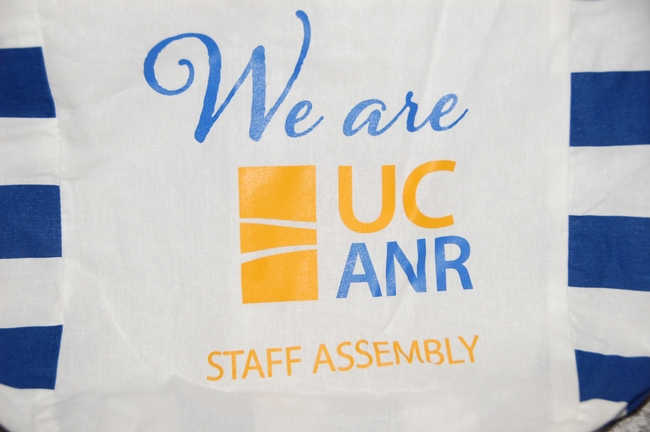Posts Tagged: John Bailey
RECs and county office staff update ANR leaders on current projects
To get acquainted with the people at each ANR location, Mark Lagrimini, vice provost of research and extension, has been visiting research and extension centers and UCCE county offices and touring the facilities.
“I'm impressed with how passionate and dedicated you are to helping people,” said Lagrimini to UCCE Contra Costa staff after listening to their project updates. He has been impressed with the work he has seen at all of his ANR visits.
On Sept. 6, Lagrimini visited Hopland Research and Extension Center, three weeks after the River Fire consumed about two-thirds of its property.
“While the River Fire damaged parts of the center, none of the main buildings, residences, livestock nor staff were hurt by the fire,” said John Bailey, Hopland REC interim director.
Scientists are invited to a site tour on Oct. 19 to learn more about research opportunities at Hopland REC.
“With Hopland REC's extensive pre-fire historical data, plus immediate post-fire, pre-rain observations that we are collecting, we have the foundation to support relevant and timely research on the effects of fire and mechanisms of recovery,” Bailey said.
AVP Wendy Powers and Mark Bell, vice provost of Strategic Initiatives and Statewide Programs, are joining Lagrimini for many of the visits to learn the latest about UCCE research and outreach and to answer questions from staff.
On Sept. 11, Rob Bennaton, UCCE director in Alameda and Contra Costa counties, introduced Powers, Lagrimini and Bell to UCCE staff in their Hayward offices, then took them to West Oakland to tour City Slicker Farms. UCCE Master Gardeners and 4-H members partner with City Slicker Farms, teaching people how to grow food at the site.
“Success to us is putting food where people need it and giving them the skills to grow food,” said Rodney Spencer, executive director of City Slicker Farms.
In Concord, Marisa Neelon, UCCE nutrition, family and consumer sciences advisor in Contra Costa County, gave Powers, Lagrimini and Bell a tour of the new office space, which includes space for Master Garden volunteers, a kitchen for nutrition educators to prepare food and a lab for farm and IPM advisors to store and analyze samples.
Staff from each unit delivered a presentation about their current projects for the ANR leaders, who were joined by Humberto Izquierdo, agricultural commissioner for Contra Costa County and Matthew Slattengren, assistant agricultural commissioner.
Charles Go, 4-H youth advisor, and Adan Osoria, EFNEP community nutrition educator, described how 4-H and EFNEP teamed up for 4-H2O, an after school project aimed at reducing consumption of sugar-sweetened beverages and increasing water consumption to improve community health and wellness. They launched 4-H2O at John Swett High School in Crockett. At the request of 4-H members, the local school board approved hydration stations and instructed the schools to provide water at meal times, Go said.
Andrew Sutherland, Bay Area urban IPM advisor, described his research on baiting for cockroaches, subterranean termites and yellowjackets and outreach to educate pest control professionals to practice IPM in schools and multi-unit housing.
“I appreciate the work Andrew does,” said Izquierdo, noting that there is a need for pest management education, especially among the county's urban and immigrant populations.
After seeing all of the presentations, Bell said, “The enthusiasm you bring to your job is inspiring.”
After the visit, Powers wrote in her ANR Adventures blog on Sept. 14: “The programs we've seen in Contra Costa and Alameda Counties this week as well as Santa Clara County a couple weeks back are good reminders of the benefits to all of UC ANR when we have strong, relevant programs in urban areas. These programs not only help the clientele, directly, but help increase the visibility of UC ANR and all of its programs across both urban and ag areas.”
On Sept. 26, Powers, Lagrimini and Bell visited UCCE Riverside, then UCCE San Bernardino the following day.
“We spent yesterday in Riverside meeting with the teams from both UCCE Riverside and UCCE San Bernardino,” Powers wrote in ANR Adventures on Sept. 27. “It was very informative, particularly seeing the fresh ideas that are coming from some of the new staff. We were able to hear about the tremendous success that both counties are having truly working as a team across program areas and layering their efforts for increased program success and support.”
Post-fire research opportunities available at Hopland REC for limited time
On July 27 and 28, the River Fire burned approximately two-thirds of the Hopland Research and Extension Center's 5,358 acres.
“While this was a dramatic event that did damage parts of the center, none of the main buildings, livestock nor staff were hurt by the fire,” said John Bailey, Hopland REC interim director.
“This event has created a unique opportunity for research,” Bailey said. “With Hopland REC's extensive pre-fire historical data, plus immediate post-fire, pre-rain observations that we intend to collect, we have the foundation to support relevant and timely research on the effects of fire and mechanisms of recovery.”
Scientists are invited to learn more about research opportunities this fall, during a webinar on Sept. 7 and a site tour on Oct. 19. The invitation is open to UC scientists and non-UC scientists.
To register for either or both events, visit https://ucanr.edu/survey/survey.cfm?surveynumber=25451.
“We will offer researchers special rates and access to the site over this brief period,” Bailey said.
Read the Hopland REC blog post at //ucanr.edu/blogs/blogcore/postdetail.cfm?postnum=28037 to learn more about the site and how you can be involved in post-fire research at Hopland REC.
For more information, join the webinar and site visit or contact Bailey at (707) 744-1424 ext 112 or jtbailey@ucanr.edu.
UC ANR and AgStart receive $500,000 to cultivate the VINE
California is constantly being challenged by pest invasions, obesity, labor shortages, water scarcity, food insecurity, climate change and more. To accelerate the development and adoption of technologies that address these challenges and advance food, agriculture and natural resources in California, UC Agriculture and Natural Resources and AgStart will receive a $500,000 grant from the U.S. Economic Development Administration (EDA) to cultivate the Verde Innovation Network for Entrepreneurship (the VINE).
Like a grapevine, the VINE will connect existing clusters of innovation across California and link entrepreneurs with mentors, advisors, collaborators, events, competitions, education and other services to turn good ideas into products and services people can use.
“We want to make sure every Californian has the support system to take a novel idea and commercialize a new product or start a new business,” said VP Glenda Humiston. “They don't have to be a university inventor, they could be a farmer or a young person.”
AgStart itself was established with an EDA i6 Challenge grant to assist agriculture and food technology entrepreneurs in the Sacramento Valley region. Since 2012, AgStart has supported more than 58 entrepreneurs and their companies.
“In 2016, of the 16 entrepreneurial companies that AgStart assisted, eight resided outside our region, and leveraged AgStart's program to make connections into our Sacramento Valley region,” said John Selep, president of AgTech Innovation Alliance, AgStart's sponsor.
“The VINE will expand this AgStart model of connecting entrepreneurs to the resources they need to be successful, to enable entrepreneurs residing anywhere in California to connect to the clusters of resources, contacts, mentors and potential partners that have emerged across the state,” said Selep.
“There are many wonderful regional innovation hubs in food, agriculture and natural resources so we plan to bring value by amplifying their efforts, connecting regions and organizations into a more cohesive ecosystem, and bringing value-added resources that ultimately benefit all Californians through the innovations affecting our economic prosperity, food supply and environment,” Youtsey said.
UC Cooperative Extension specialists and advisors, who work in every county, can provide insight into real-world conditions that entrepreneurs should consider in the development stage. UC ANR's nine research and extension centers can provide locations to field-test products and demonstrate their effectiveness. For example, start-up Blue River is testing its technology by flying a drone over sorghum crops to collect data at the UC Kearney Agricultural Research and Extension Center in Parlier.
For the last two years, UC ANR has hosted the Apps for Ag hackathon and has introduced the winners to mentors, tech industry advisors, farmers, funders and legal experts who can advise entrepreneurs on business structure.
The VINE, which is working with UC Davis Innovation Institute for Food and Health and Valley Vision, is being structured to complement other efforts to establish food, agriculture, and natural resources incubation and innovation resources in cluster locations around the state, such as the BlueTechValley Regional Innovation Cluster, the Western Growers Innovation & Technology Center, UC Merced's VentureLab and others.
Youtsey and Selep are seeking more VINE partners with expertise across the business spectrum.
“If our vision is successful, the VINE will make California the most fertile region in the world for entrepreneurs in ag and food technology to establish themselves, to prosper and grow,” Selep said.
Names in the News
Slattery rejoins UCCE in Butte County
Chelsey Slattery rejoined UC Cooperative Extension on Sept. 18, 2017, as an area nutrition, family, and consumer sciences advisor in Butte County.
From 2013 to 2016, Slattery was a UCCE community education specialist, supervising the UC CalFresh Nutrition Education Program in Colusa, Sutter and Yuba counties.
From July 2016 to September 2017, Slattery was a program manager at UC Davis Center for Nutrition Schools, where she oversaw a statewide, multi-component, evidence-based, and research-tested nutrition education program. She facilitated training in coordination with the UC CalFresh State Office and UC CalFresh counties throughout the state of California.
Concurrently, Slattery has been working as a per-diem nutrition specialist since 2015 at Shady Creek Outdoor Education Foundation, where she provides oversight and guidance for the Fit Quest program, bringing comprehensive children's wellness programs to Northern California schools.
Slattery earned an M.S. in organizational leadership from the School of Business Management at National University. She completed a B.S. in exercise physiology/exercise science from CSU Chico.
Based in Oroville, Slattery can be reached at (530) 538-7201 and cslattery@ucanr.edu.
California Naturalist wins ANROSP outstanding team award
The California Naturalist Program was named the 2017 Outstanding Team by the Alliance of Natural Resource Outreach and Service Programs (ANROSP). Sabrina Drill, associate director of California Naturalist and UC Cooperative Extension advisor, and Marisa Rodriguez, community education specialist with California Naturalist in Southern California, accepted the award on Sept. 21 at the annual ANROSP conference held at the World Forestry Center in Portland, Ore.
Led by director Adina Merenlender, a UC Cooperative Extension specialist at UC Berkeley, the CalNat staff includes Greg Ira, academic coordinator; Brook Gamble, community education specialist; Drill and Rodriguez.
Teamwork is fundamental to the program structure. Since 2012, California Naturalist has certified more than 1,800 Naturalists, who have logged over 100,000 volunteer hours.
The team credits its success to the support and efforts across UC ANR and an extended team of course partners, instructors, statewide partners, educators, scientists, conservation practitioners, and many others who have contributed to the continued adaptive development of the program.
Grant to be inducted into Ag Hall of Fame
On Oct. 19, Joseph Grant, UC Cooperative Extension advisor emeritus, will be among the people inducted into the San Joaquin County Agricultural Hall of Fame at the 33rd Annual Agricultural Hall of Fame Banquet.
For most of his career, Grant, who retired in 2016, worked as a UC Cooperative Extension farm advisor and is known for his research on walnuts, cherries, apples, olives and other tree crops.
“It's kind of awesome. I mean when you look at the other people that have been inducted into the Hall of Fame, I don't consider myself in that class of people so it's humbling,” Grant said about his induction to the Lodi News-Sentinel.
In addition to Grant, the San Joaquin County Agricultural Hall of Fame will honor Henry “Skip” Foppiano, Jack and Pati Hamm and Hank Van Exel, and give a posthumous honor to winemaker Robert Gerald Mondavi.
According to the Hall of Fame, it “honors those individuals who have contributed to agriculture and to their community in significant ways.”
The banquet will be held at the Robert J. Cabral Ag Center in Stockton. Tickets are $45 and can be purchased by calling the Greater Stockton Chamber of Commerce at (209) 547-2770 or by visiting http://stocktonchamber.org/ag-hall-of-fame.
USDA-ARS bestows B.Y. Morrison Medal on Zalom
Frank Zalom, UC Davis distinguished professor of entomology and integrated pest management (IPM) specialist, has been named the recipient of the 2017 B.Y. Morrison Medal by U.S. Department of Agriculture/Agricultural Research Service (USDA-ARS).
Zalom is the first entomologist to receive the coveted award established in 1968, according to Kim Kaplan of the USDA-ARS Office of Communications.
Zalom was singled out for his outstanding work in IPM related to sustainable horticulture production, specifically for “his outstanding leadership and public service in IPM for horticultural crops at the regional, state, national and international levels; his stellar accomplishments in horticultural crops sustainability and pest management and his work ethic, service, courage and integrity, all driven by his insatiable curiosity and passion to solve problems in the horticultural crops landscape,” Kaplan said.
Zalom received the award, co-sponsored by USDA-ARS and the American Society for Horticultural Science (ASHS), on Sept. 21 at the ASHS conference in Waikoloa, Hawaii. He presented the Morrison Memorial Lecture on “Significance of Integrated Pest Management to Sustainable Horticultural Production – Observations and Experiences.”
Read more at //ucanr.edu/blogs/blogcore/postdetail.cfm?postnum=25218. -- Kathy Keatley Garvey
UC ANR Staff Assembly Updates
Ambassadors Meeting
The UC ANR Staff Assembly Council will hold a Staff Assembly Ambassadors meeting at the ANR Building in Davis on Oct. 10. The engagement will provide an opportunity for ambassadors to visit and network with colleagues and review Staff Assembly priorities. Additionally, they will discuss opportunities for staff to become more involved in addressing staff concerns and furthering organizational goals.
UC ANR Tote Bags
In an effort to help spread the word about UC ANR Staff Assembly, all Staff Assembly members will receive a We Are UC ANR Staff Assembly tote bag. Members of the UC Staff Assembly include all ANR staff, whether employed by the county or the university, represented by a union or not represented. UC ANR Staff Assembly Ambassadors are the points of contact for distributing the bags at each office.
CUCSA Fall 2017 Meeting
UC San Diego was the site of the CUCSA (Council of University of California Staff Assemblies) Fall 2017 Meeting Sept. 6-8. The meeting included a team building exercise, work group action planning, post retirement health benefit discussions and a review of UC Employee Engagement Survey results. UC ANR junior delegate LeChé McGill and senior delegate Jeannette Warnert represented UC ANR staff at the meeting.
On the subject of potential changes to post-retirement health benefits, CUCSA chair Lina Layiktez provided the summary below and links for more information.
Proposed change to post-retirement health benefits
The proposed action item for the July 2017 Regents meeting was to remove the 70 percent floor on the UC contribution to retiree health benefits and place a cap of 3 percent on year-over-year increases to UC costs. This is a policy change to offset the accounting rule changes required in "GASB 75." GASB 75 requires that the full actuarial value of other postemployment benefits (OPEB) be included on the systemwide balance sheet. This means that UC will have a perceived “new” liability of $21 billion, which would affect the system's overall credit rating. A hit to the UC's credit rating has obvious impacts to financing for the university.
The “new” GASB 75 requirement definition is subject to interpretation, since it was already a liability that was disclosed in previous year's financials. The value of this liability under current assumptions/retiree rules is approximately $21 billion. The current assumptions are being driven by the number of retirees in the system plus the number of potential retirees (active staff and faculty) and how much it would cost the system in health-care costs should the current employees retire today.
What does this all mean?
By removing the floor and capping UC's costs, the university effectively transfers rising health-care premiums to retirees. The assumed rate of health-care cost increase is 7 percent. Over the course of 20 years this would flip the proportion that UC pays to ~30 percent and the retiree to ~70 percent. The 70 percent floor was designed to provide some stability to retiree health-care costs.
What do we see happening?
Many UC employees choose to retire after calculating their retirement income. This is necessary because, except for Cost of Living Adjustments (COLA), there is no way for retirees to increase their income from the university. So when out-of-pocket health-care costs go up for retirees, this eats into their living expenses. There are already retirees and survivors of retirees who have to choose between health-care costs and food. To suddenly remove the 70% floor exacerbates this problem.
What can you do?
The campus staff assemblies are collecting feedback locally and sharing this up to the Council of UC Staff Assemblies (CUCSA), who will be coordinating a response to the UC President and/or Board of Regents. We are also working on a list of questions that include queries, such as what OPEB would look like if it grandparented current employees and implemented the changes to future retirees? What does this mean for retention of employees with 10 to 20 years of service?
The most powerful and helpful thing for us now is to hear about your personal concerns and how this impacts you. Would no OPEB mean you are less likely to retire from the UC system and take a job elsewhere for more money now? Will you have to postpone your retirement if, in retirement, you will have to pay a greater portion of your OPEB than you had planned for under the current plan?
Share your questions and stories with us on the UC ANR Staff Assembly website.
What's next?
Fortunately, the July agenda was revised and this item was moved to the November meeting agenda. Moving the item to November will allow for more consultation and discussion. It is unknown what approach the UC Office of the President (OP) will take to solicit feedback and engage in discussion. But as that information becomes available, we will make sure to share it broadly. We are hopeful that CUCSA (and therefore a voice of staff) will be included in the discussions and that OP will convene a task force representing all parties that will be affected by the proposed changes. Stay tuned.
Click here for the original July Regents Meeting Agenda Item (F7), which was then revised to remove the discussion on the 70 percent floor.
The immediate past chair of the systemwide Academic Senate, Jim Chalfant, has already written a letter to the UC President on this issue. You can read it online here: http://senate.universityofcalifornia.edu/_files/reports/JC-JN-Retiree-Health.pdf.
We can work collectively to inform and educate staff on this important matter. We are stronger together and the more voices that participate, the louder the message will be to those making the decisions that affect all of us.
UC ANR human resources director John Fox also said one important point that isn't addressed in the CUCSA summary is Medicare coverage. “When a UC retiree enrolls in Medicare, the monthly medical premium costs are significantly reduced (both for the retiree and for UC). Much of the future liability that UC is trying to control (and the risk of high monthly costs for the retirees) is during the time between retirement from UC and the start of Medicare eligibility (typically age 65).”
If you would like to share your stories or post a comment on this proposed change, please fill out the form on the UC ANR Staff Assembly website. We will share comments and stories from UC ANR with CUCSA leadership, who will compile it with information from other campuses to share with the UC President and UC Regents.

